Hurricane Creek
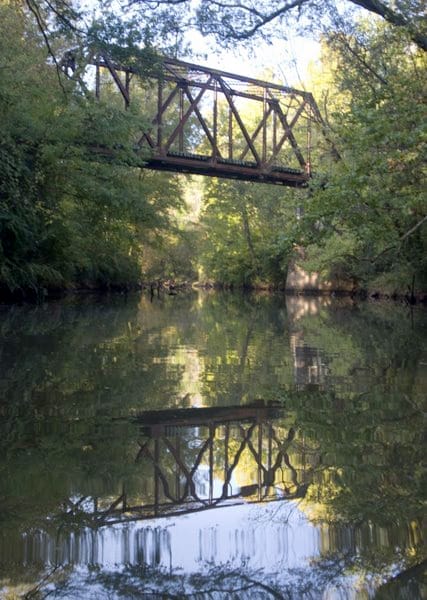 Bridge over Hurricane Creek
Hurricane Creek, in the eastern part of Tuscaloosa County, has earned a reputation among outdoors enthusiasts for its natural beauty. It has been a prime recreational draw for at least a century and a half, hosting church baptisms, fishing trips, family picnics, overnight rafting parties, and swimmers. Hurricane Creek’s location is unique in that it spreads into the westernmost point of the Southern Appalachians. As such, it is the southernmost free-flowing stream in Appalachia. Located on a geological fault, the creek flows along a mountainous range composed of sandstone, limestone, and shale that dates from the Pennsylvanian period (320 to 286 million years ago) known as the Pottsville Formation. Other portions of the creek flow through the Eastern Gulf Coastal Plain, dating to two million years ago. The creek also flows over the Warrior Coal Basin, where Alabama’s first mineral economy had its origin, and its ecological habitat provided world-renowned Harvard entomologist Edward O. Wilson with the site of his first scholarly study of ants.
Bridge over Hurricane Creek
Hurricane Creek, in the eastern part of Tuscaloosa County, has earned a reputation among outdoors enthusiasts for its natural beauty. It has been a prime recreational draw for at least a century and a half, hosting church baptisms, fishing trips, family picnics, overnight rafting parties, and swimmers. Hurricane Creek’s location is unique in that it spreads into the westernmost point of the Southern Appalachians. As such, it is the southernmost free-flowing stream in Appalachia. Located on a geological fault, the creek flows along a mountainous range composed of sandstone, limestone, and shale that dates from the Pennsylvanian period (320 to 286 million years ago) known as the Pottsville Formation. Other portions of the creek flow through the Eastern Gulf Coastal Plain, dating to two million years ago. The creek also flows over the Warrior Coal Basin, where Alabama’s first mineral economy had its origin, and its ecological habitat provided world-renowned Harvard entomologist Edward O. Wilson with the site of his first scholarly study of ants.
Pronounced “HAIR-uh-kin” Creek by older residents, the waterway often produces a roaring sound like a hurricane as it rushes over its rocky bed. It flows from the confluence of Davis and Coal Creeks in the town of Vance and runs west for approximately 26 to 28 miles. The creek also meanders through the communities of Brookwood, Vance, Peterson, Coaling, Cottondale, and Holt, where it enters the Black Warrior River.
Hurricane Creek’s banks are bordered by a wide variety of trees—including birch, beech, oaks, poplars, sycamores and southern longleaf pines—that form a tall canopy. Understory trees include dogwoods, redbuds, and hollies. Stands of big-leaf magnolia, known locally as “cowcumbers,” can be found in most every plot of woods along the creek course, producing large white flowers in late spring. Some of the cedars that line the creek are so massive that they may be several hundred years old.
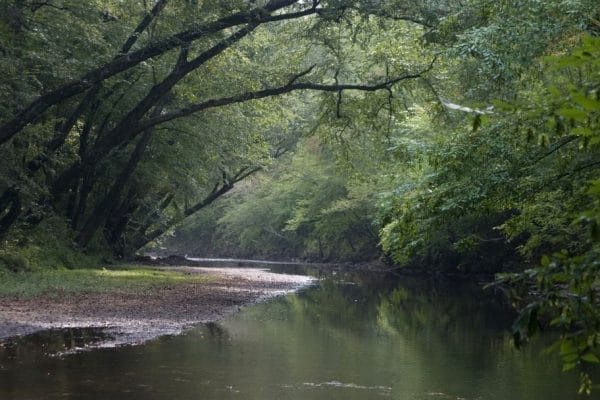 Birches Hanging over Hurricane Creek
During autumn and spring, wildflowers appear along the creek banks, with others emerging sporadically at other times of the year. Near the headwaters at Vance, cardinal flowers bloom in mid to late summer, with the most impressive displays being found at the creek mouth, near where it spills into the Black Warrior. Other wildflowers found along the creek are dwarf iris, Carolina lily, queen-of-the-meadow, button bush, and the white, low-blooming Atamasco lily, often referred to as the Easter lily. Spiderwort, bearing flowers from dark pink to purple, is profuse along the creek’s length, especially near the railroad trestle at the creek mouth.
Birches Hanging over Hurricane Creek
During autumn and spring, wildflowers appear along the creek banks, with others emerging sporadically at other times of the year. Near the headwaters at Vance, cardinal flowers bloom in mid to late summer, with the most impressive displays being found at the creek mouth, near where it spills into the Black Warrior. Other wildflowers found along the creek are dwarf iris, Carolina lily, queen-of-the-meadow, button bush, and the white, low-blooming Atamasco lily, often referred to as the Easter lily. Spiderwort, bearing flowers from dark pink to purple, is profuse along the creek’s length, especially near the railroad trestle at the creek mouth.
Wildlife at Hurricane Creek is typical of most Appalachian woodlands: deer, possums, canecutter rabbits (also known as swamp rabbits), squirrels, groundhogs, and snakes. Turtles sun themselves on tree limbs stretching out into the creek. Fresh animal tracks are often visible on the creek’s myriad sandbars, and many creek enthusiasts have reported sightings of bobcats and coyotes. The creek habitat is also visited by red-tailed hawks, ospreys, pileated woodpeckers, wood ducks, great blue herons, and Alabama’s state bird, the brightly colored woodpecker known as the yellowhammer, or northern flicker. Eagles have been sighted near the creek mouth.
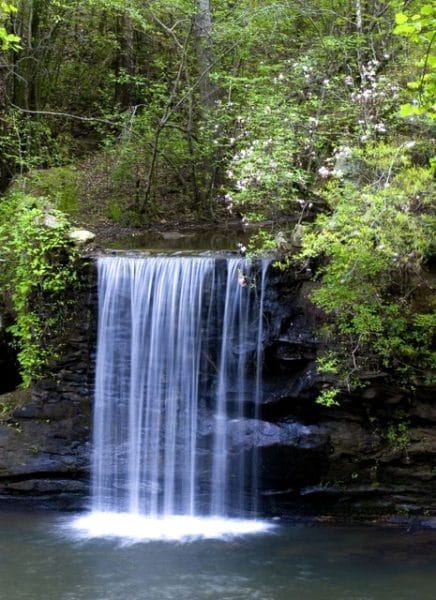 Waterfall on Hurricane Creek
Inhabitants of the stream itself include an increasing number of fish species and equally increasing overall populations, including spotted gar, catfish, bass, and bream. Pools topping sandy beaches adjacent to the creek often include tadpoles, and boulders in the stream host slugs and snails. Frogs are large enough for gigging. Insect life includes damselflies, Alabama’s state butterfly, the eastern tiger swallowtail, and the state insect, the monarch butterfly. In the creek itself, mayfly, stonefly, and caddisfly larvae thrive.
Waterfall on Hurricane Creek
Inhabitants of the stream itself include an increasing number of fish species and equally increasing overall populations, including spotted gar, catfish, bass, and bream. Pools topping sandy beaches adjacent to the creek often include tadpoles, and boulders in the stream host slugs and snails. Frogs are large enough for gigging. Insect life includes damselflies, Alabama’s state butterfly, the eastern tiger swallowtail, and the state insect, the monarch butterfly. In the creek itself, mayfly, stonefly, and caddisfly larvae thrive.
Archaeological evidence indicates that Native Americans inhabited the creek watershed from about 10,000 B.C. Some land adjacent to the creek was part of a trail known as the Bear Meat Path, used by regional Indian groups in their travels from north Alabama into present-day Tuscaloosa County. In 1847-48, University of Alabama geologist Michael Tuomey made the first geological survey of the state of Alabama and discovered high-grade coal along the banks of Hurricane Creek. His findings led to development of the Warrior Coal Basin, a rich vein of coal that underlies the creek. Less than a half-century later, geological reports about the area’s coal caught the attention of geologists across this country and in Europe, many of whom came to study the basin.
Roland Harper, a botanist and geographer with the Geological Survey of Alabama during much of the first half of the twentieth century, consistently studied the natural habitat of Hurricane Creek and recorded his findings in diaries now housed at the W. S. Hoole Special Collections Library at the University of Alabama. He was among the first to describe a low white native azalea that is now known as the Alabama azalea (Rhododendron alabamense Rheder). This rare species grows profusely up and down the creek, displaying its snowy white flowers, each with a prominent yellow blotch and a lemony fragrance. In addition, the rare silky camellia (Stewartia malacodendron L.), a small tree or shrub also found at the creek by Harper, continues to bloom in the area’s moist woods, each flower projecting purple filaments from the center of five petals.
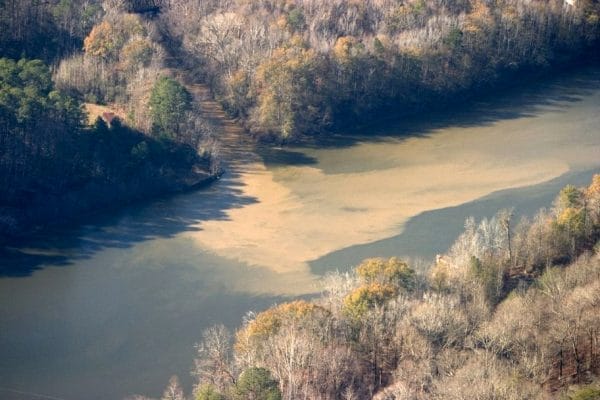 Runoff Pollution in Hurricane Creek
During the 1920s, pollution from primitive strip mining caused large-scale fish kills and widespread siltation of the creek. Legal action stopped the mining, but the environment took decades to recover. In 1944, Reichhold Chemicals Inc. began manufacturing organic chemicals, synthetic resins, and various industrial chemicals, operating until 1986 on the Black Warrior River near the creek mouth at Holt. From the beginning, it was accused of dumping barrels of dye into the creek mouth. Officials administering state and federal rules historically reported findings of environmental compliance, but the site continued to be monitored from time to time by the U.S. Environmental Protection Agency. In 2010, a complaint lodged by a private citizen with the EPA spurred an investigation, with the agency reportedly finding no problems. The investigation did not, however, include Hurricane Creek or its banks. Strip mining continues to cause siltation in the creek, as does nearby construction, road building, coalbed methane well procedures, road maintenance activities, and runoff. In 2008, raw sewage seeping into the stream caused a temporary ban on fishing and swimming.
Runoff Pollution in Hurricane Creek
During the 1920s, pollution from primitive strip mining caused large-scale fish kills and widespread siltation of the creek. Legal action stopped the mining, but the environment took decades to recover. In 1944, Reichhold Chemicals Inc. began manufacturing organic chemicals, synthetic resins, and various industrial chemicals, operating until 1986 on the Black Warrior River near the creek mouth at Holt. From the beginning, it was accused of dumping barrels of dye into the creek mouth. Officials administering state and federal rules historically reported findings of environmental compliance, but the site continued to be monitored from time to time by the U.S. Environmental Protection Agency. In 2010, a complaint lodged by a private citizen with the EPA spurred an investigation, with the agency reportedly finding no problems. The investigation did not, however, include Hurricane Creek or its banks. Strip mining continues to cause siltation in the creek, as does nearby construction, road building, coalbed methane well procedures, road maintenance activities, and runoff. In 2008, raw sewage seeping into the stream caused a temporary ban on fishing and swimming.
In the mid-1990s, a group of concerned citizens organized the non-profit Friends of Hurricane Creek, affiliated with the international Waterkeeper Alliance, to advocate for the protection and preservation of the creek and its surrounding habitats. The organization, which now numbers 180 members, holds annual creek clean-up events and has pioneered a procedure for citizen’s to file complaints about threats to the creek and engages in grassroots campaigns to protect the creek and its ecology and pursues legal action to end pollution.
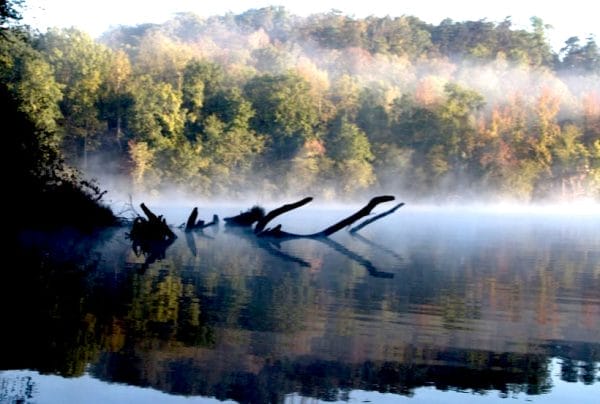 Hurricane Creek
Much of the creek habitat is privately owned and therefore inaccessible to the general public. Few roads penetrate the area, providing wildlife with a safe haven and a peaceful environment for those who enter it. However, there are two publicly accessible water routes which enable visitors to experience the creek fully. The Riverview put-in on the Black Warrior River, off Jack Warner Parkway, allows canoers and kayakers to access the creek mouth less than a half hour’s paddle from river entry. Sights inside that creek portal include a lush biodiverse forest, gigantic sandstones, and a picturesque 1905 railroad trestle from the region’s coal mining days.
Hurricane Creek
Much of the creek habitat is privately owned and therefore inaccessible to the general public. Few roads penetrate the area, providing wildlife with a safe haven and a peaceful environment for those who enter it. However, there are two publicly accessible water routes which enable visitors to experience the creek fully. The Riverview put-in on the Black Warrior River, off Jack Warner Parkway, allows canoers and kayakers to access the creek mouth less than a half hour’s paddle from river entry. Sights inside that creek portal include a lush biodiverse forest, gigantic sandstones, and a picturesque 1905 railroad trestle from the region’s coal mining days.
In July 2008, the Tuscaloosa County Commission purchased a 249-acre wilderness area called the M Bend, which more than three miles of creek frontage on the waterway’s north side. The family of the late Stanley Park Sr. sold it to the Trust for Public Land, which held it until purchase by the Tuscaloosa County Park and Recreation Authority. It is now known as Hurricane Creek Park.
Further Reading
- Callahan, Nancy. Hurricane Creek: Personal Accounts & Collected Lore. New York: Crescent Ridge Publishing, 2019.



